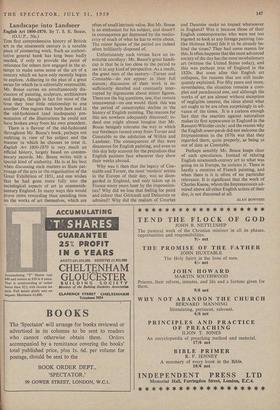Landscape into Landseer English Art 1800-1870. By T. S. R.
Boase. (O.U.P., 50s.) THIS first comprehensive history of British art in the nineteenth century is a notable piece of pioneering work. Such an authori- tative general book has long been badly needed, if only to provide the point of reference for others now engaged in the at- tempt to make some sense of the art of a century which we have only recently begun to explore. Adhering to the plan of a great series for which he is editorially responsible, Mr. Boase carries on simultaneously dis- cussion of painting, sculpture, architecture and design, though in fact for most of the time they bear little relationship to one another. One regrets that both here and in the old-fashioned (and inadequate) pre- sentation of the illustrations he could not have broken away from his own precedent.
There is a flavour of the old-fashioned throughout Mr. Boase's book, perhaps not unfitting in view of his subject and the manner in which he chooses to treat it. English Art 1800-1870 is very much an official history, largely based on contem- porary records. Mr. Boase writes with a special kind of authority. He is at his best when discussing such matters as State pat- ronage of the arts or the organisation of the Great Exhibition of 1851, and one wishes that he had gone more fully into the sociological aspects of art in nineteenth- century England. In many ways this would prove more rewarding than spending time on the works of art themselves, which are
often of small intrinsic value. But Mr. Boase is an enthusiast for his subject, and doesn't in consequence get depressed by the medio- crity of much of what he has to write about. The minor figures of the period are indeed often brilliantly disposed of.
Unfortunately such virtues have an in- evitable corollary: Mr. Boase's great handi- cap is that he is too close to the period to see it in any kind of perspective. As a result, the great men of the century—Turner and Constable—do not appear in their full stature; discussion of their work is in- sufficiently detailed and constantly inter- rupted by digressions about minor figures. There are the big questions, too, that remain unanswered—no one would think this was the period of catastrophic decline in the history of English painting. The reasons for this are nowhere adequately discussed; in- deed one might almost imagine that Mr. Boase benignly tolerates the way in which our forebears turned away from Turner and Constable to the adulation of Wilkie and Landseer. The consequences of this were disastrous for English painting, and even to this day help account for the prejudices that English painters face whenever they show their works abroad.
Why was it then that the legacy of Con- stable and Turner, the most 'modern' artists in the Europe of their day, was so disre- garded in England, and only taken up in France many years later by the impression- ists? Why did we lose that feeling for paint and colour that GOricault and Delacroix so admired? Why did the realism of Courbet
and Daumier make no impact whatsoever in England? Was it because those of their English contemporaries who were not too bigoted to look at any foreign painting (un- like Holman Hunt) felt it to be already be- hind the times? They had some reason for this. It often happens that the most advanced society of the day has the most revolutionary art (witness the United States today), and this was perhaps true of England in the 1820s. But soon after this English art collapses, for reasons that are still inade- quately explained. For fifty years and more, nevertheless, the situation remains a com- plex and paradoxical one, and although the works of art are almost without exception of negligible interest, the ideas about what art ought to be are often surprisingly in ad- vance of the times. It is a curious enough fact that the reaction against naturalism makes its first appearance in England in the Rossetti-Whistler circle; and the reason why the English avant-garde did not welcome the Impressionists in the 1870s was that they regarded them, quite properly, as being as out of date as Constable.
Perhaps sensibly Mr. Boase keeps clear of such speculation. Instead of relating English nineteenth-century art to what was going on in Europe, he isolates it. There is hardly a mention of French painting, and when there is it is often of no particular relevance. It is significant that the work of Charles Keene, whom the Impressionists ad- mired above all other English artists of their day, is not discussed at all.
ALAN BOWNESS






























 Previous page
Previous page